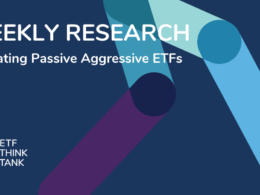In last week’s ETF Think Tank research note, we compared the top 25 holdings in ETFs, Mutual Funds, and Robinhood.
This week, we consider recent market volatility and analyze the ETFs we’ve identified as falling within the low volatility bucket. Advisors looking for investment options for clients who are more risk-averse should know there is an entire category of ETFs available to soften the highs and lows.
On the Defense
As of May 31, 2019 it is clear that certain equity investors are getting more defensive into the summer as we make new highs. According to Bloomberg, US-listed ETFs experienced net outflows of $14.4 billion, the largest monthly outflow in 5 years. Risk-off positioning led investors to rotate over $20 billion out of equity-focused ETFs during May, led by minimum volatility ETFs. Factor ETFs had $5.5 billion in inflows. This of course can change on a dime – one catalyst could be positive news about China. Nevertheless, we are due for some volatility, so what better time to examine low volatility ETFs.
Breaking Down the Min/Low Vol ETF Market
The ETF Think Tank was created because we believe an unbiased view of innovative investment products can serve the interests of the end investor. To that end, we want to note that there are 28 ETFs with AUM of greater than $50 million in the min/low volatility category, which means there is plenty of opportunity to invest across the globe using this important factor.
The ETF Think Tank was created because we believe an unbiased view of innovative investment products can serve the interests of the end investor. To that end, we want to note that there are 28 ETFs with AUM of greater than $50 million in the min/low volatility category, which means there is plenty of opportunity to invest across the globe using this important factor.
It is difficult to challenge the index construction for either USMV or SPLV. Historically, it is clear that these funds have delivered on their stated strategic goals, but certain tactical investors may seek to reposition and / or diversify using other factors (Beta) and asset classes that go up in value when stocks go down.
To highlight the long-term value of these two funds we provide index-based returns below in Chart A dating back to 2007.
- MOOIMV$T Index is the benchmark index for USMV
- SP5LVIT is the benchmark for USMV
Tracking error may exist for all funds. Even so, the benchmark performance seems especially reasonable in this case. According to Bloomberg, during the past 5 years, tracking error for USMV and SPLV vs. their benchmarks has been 16 and 29 basis points respectively, and in line with their difference in fees.

Moreover, the return performance for these two funds in 2018 also validates the index construction and probably is part of the reason for their recent inflows. However, alpha can be packaged in different ways. In the chart below, we also include the AGFiQ Market Neutral Anti-Beta ETF (BTAL), which as a hedge could have helped to smooth out the ride in an overall low beta strategy last year.

Why Look at Other Min/Low Vol ETFs
We are advocates for innovation and encourage investors to continue to look deep under the hood. After all, minimum or low volatility trends could change, and these are passive solutions. The creative potential of next generation ETFs excites us, and as markets change so will the risks. What we know today is that circumstances will almost certainly be different than they were in 2008 and thankfully the choice of solutions is far more robust. A 38% decline in the markets left plenty of room for improvement in 2008. And although a decline of 25.45% for the index for USMV and 23.07% for the index for SPLV is a meaningfully better drawdown, this is still something that investors want to avoid if and where possible.
Using the 2008 crisis as an example, we look back at how owning other asset classes and Beta as a factor might have worked. In other words, the benchmark index that the AGFIQ Anti-Beta Market Neutral ETF (BTAL) is driven by, provided upside of 46.9% as reported by Bloomberg in the DJMNABT Index. Of course, this was a unique set of circumstances and is being provided for illustrative purposes only.


Different Methodologies Define What Min/Low Vol is:
Using the ETF Think Tank Portfolio Comparison Tool, what two things that we find most extraordinary about this horse race is that the ETFs only have a 46% overlap in their holdings and this massive outperformance has been achieved during a period of time where volatility has been very low.


Conclusion
Past performance may not be indicative of future results and the volatility factor that defines USMV and SPLV may have different outcomes in different market conditions. It is for this reason we encourage innovative thinking and research around the next generation of ETFs focused on the factor methodologies. Moreover, given the 46% overlap between these two ETFs is targeted at the same goal, we encourage investors to look at the ETF Think Tank Security Master for answers on what other ETFs might serve as solution for managing portfolio and market volatility. Lastly, in the spirit of the G20 Summit we will be looking deeper under the hood with how the factor has performed internationally and in the emerging markets.
It may not be a coincidence that large funds and outperformance also exist for the min/low factor across EAFA, Emerging markets and Global: iShares Edge MSCI Min Vol EAFE (EFAV), iShares Edge MSCI Min (Emerging Market ETF (EEMV), iShares Edge MSCI Min Vol (Global ETF (ACWV) and Powershares S&P Midcap Low/Volatility ETF (XMLV).
Three Mystery Questions for the ETF Nerds and Members of the ETF Think Tank:
- Which has more overlap with the SPY? USMV or SPLV
- Why does it make sense that USMV lowered its Fee while it does not make sense for SPLV. Hint: Check out the Smart Cost calculator™
- What is the overlap between SPMV and SPLV?
TETF.Index Performance

Returns as of June 24, 2019.
Inception Date: April 4, 2017.
Index performance is for informational purposes only and does not represent the ETF. Indexes are unmanaged and one cannot invest directly in an index. Past performance is NOT indicative of future results, which can vary.
TETF.Index Performance vs. Leading Financial Indexes

Click here for information on the Index following the ETF industry












